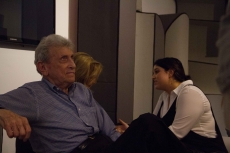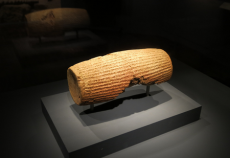The CPD Blog is intended to stimulate dialog among scholars and practitioners from around the world in the public diplomacy sphere. The opinions represented here are the authors' own and do not necessarily reflect CPD's views. For blogger guidelines, click here.

Remembering Jack Masey, a giant in American public diplomacy.

It is always heartening to hear discussion of historical artifacts not strictly as museum pieces but as instruments that can transmit other cultural messages and interpretations of identity. The Cyrus Cylinder is an example of ancient cultural heritage that resonates with new meanings today. Inspired by the blogs by Jay Wang and Naomi Leight my interest was sparked on this subject.
I have spent some time as of late picking through the now infamous train wreck that was the American pavilion at Shanghai. Cynthia Schneider offers her opinion on what went wrong here. Here’s my take:
As a museum curator who has spent most of the last decade dabbling in the collection and display of objects in order to frame rich historical narratives for the civic and educative enrichment of culturally diverse audiences, I can conscientiously admit that there are things an exhibition is capable of doing and things an exhibition cannot accomplish. In fact, it is folly to say one knows exactly just what impact an exhibition with any given theme may have on any audience whatsoever.
The title for this commentary is deliberately borrowed from Russian composer Modest Mussorgsky’s famous piano composition of 1874. It also underscores the tone for this review of a recent exhibition that has opened in Los Angeles, “The 21st Century Family of Man: Photography as Public Diplomacy,” on display in the second floor gallery of USC’s Annenberg School for Communication.
Last week I attended "Face-off to Facebook: From the Nixon-Khruschev Debate to Public Diplomacy in the 21st Century", a conference sponsored by George Washington University's Institute for Public Diplomacy and Global Communication at the School of Media and Public Affairs. The event was a celebration of the 50th anniversary of the American National Exhibition in Moscow and the infamous impromptu tête-à-tête that took place between Vice President Richard Nixon and General Secretary Nikita Khruschev.
Cultural historians mostly discourage making cross-history comparisons of important events, since they take place in fundamentally different contexts and the parallels that are drawn are rarely meaningful or useful. With that caveat, I will argue how President Obama's administration might best utilize the soft power of cultural diplomacy by recalling a similarly pivotal moment from March 4, 1933.
POPULAR ARTICLES
-
June 5
-
June 18
-
June 6
-
June 5
-
May 8
-
June 19
-
May 15
-
June 11
Featured Blogger
Join the Conversation
Interested in contributing to the CPD Blog? We welcome your posts. Read our guidelines and find out how you can submit blogs and photo essays >.








